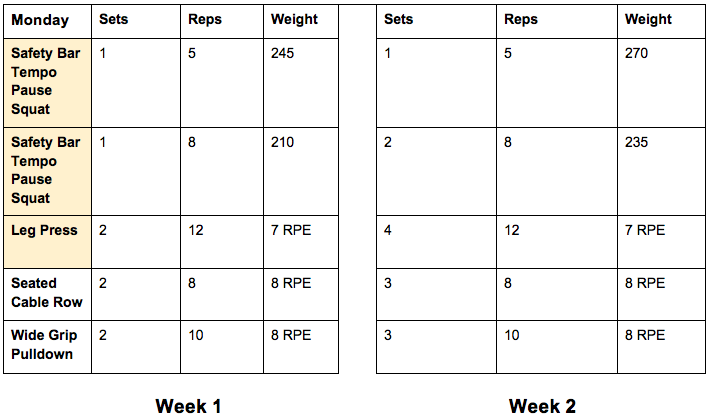
Intro Week: An introduction back into training after a prolonged break, or the introduction of a new stimulus, during which training intensity is decreased to allow for gradual implementation of the SAID principle (specific adaptations to imposed demands).
Have you ever taken a week completely off due to injury, travel, or just a general break from training, to then return to training and become extremely sore and already feel beat down after the first week back? Or maybe you introduced a new exercise back into the routine and now you can’t walk right for the next couple days? Or maybe, worst-case scenario, you had a small overuse injury and had to take a week or two off, and after hopping back into the first week of training you've now aggravated something else?
All three have happened to me at times, giving me this feeling of having to dig myself out of a hole for the remainder of the training block. Fortunately, there is a simple fix that I wish I would have used sooner. Many template-style training programs that are available online do not account for this issue. Instead of having you gradually work back into training, they have you just jump straight into training with similar volume loads during that first week as four or five weeks down the road. The human body has an amazing ability to adapt. We can help that process by not just throwing ourselves back into training full-boar, but instead allowing our body to gradually adapt to the imposed demands we place upon it.
RELATED: Properly Using Deload for Maximum Gains
Before diving into how to program an intro week, let’s first look at the best times to implement an intro week. I see four main scenarios that would warrant this reintroduction into training:
- After a meet, where many times you have taken some time off to fully recover before getting back into training.
- After a prolonged break in training, whether due to vacation, a small injury that required a week or two off, or another reason.
- When working back into a volume-based cycle, as these higher volume loads tend to cause more fatigue and soreness. Many times this is after a meet as well, so it is double the trouble with having just taken a prolonged break and now introducing a new phase of training that is imposing very different demands from what you went through during meet prep.
- For a new exercise that you have never done before or maybe are just reintroducing back into your training after a period of time without it.
For the first three scenarios, the programming of an intro week is going to be the same. The first thing I do is write out the training block as I normally would. So let’s say this is a four-week training block with a deload on the fifth week. I will program everything out as if I am just simply transitioning to my next block in training, not yet taking into account a need for a reintroduction to training. Once I have those weeks written out, I will then add a week that precedes this block, which will be the intro week, now making this training cycle five weeks total with a deload on the sixth week. This first week, though, will have a significant drop in volume a slight drop in intensity. Below is a chart of an example of the reduction in weight and volume from the first to second week in a typical intro to full training program transition.
Regarding actual calculations that go into this during the intro week programming, you are performing about 60% of the volume of the following week. You will set the squat, bench press, deadlift, and any additional variations of the three at 90% intensity. Intensity should be kept generally the same for most of the accessory movements if the athlete has been performing the movements in prior blocks. I will demonstrate later in this article how to adjust accessory movements that instead are new or are being reintroduced to the athlete's training. When programming this intro week, I also typically drop the volume more for accessory movements that are going to be using heavier loads, such as the leg press in this example. I worry more about the leg press causing increased soreness, resulting in a negative effect on training in coming weeks, than I worry about a seated cable row.
RECENT: Alternatives to Squat Training After Overuse Injuries
For the fourth scenario outlined above (a new exercise that you have not been currently doing is added back in), there will be a difference in how to program this depending on the circumstance. If this new exercise is also occurring at the same time as one of the first three scenarios, there will already be a volume reduction implemented to that exercise within that intro week, so the only thing I would add is an extra drop in intensity. For example, maybe from an 8 RPE down to a 7 RPE.
If this new exercise, on the other hand, is standalone, meaning the rest of your training is staying the same and you need to just program a reintroduction for that single exercise, the approach is slightly different. Using the same example as above, I will program out a four-week block with a deload on the fifth week. But now instead of adding an intro week, I will just reprogram that single exercise.
So, let’s say that exercise is leg press—which would classify as an exercise that uses heavier loads—and the original program states to perform that exercise for four sets of 12 at 8 RPE. Alter the weeks as such:
- Week 1: 2 x 12 at 7 RPE
- Week 2: 3 x 12 at 8 RPE
- Week 3: 4 x 12 at 8 RPE
If the exercise instead is an accessory movement that causes less fatigue than the leg press, such as a seated cable row programmed at three sets of eight at 8 RPE, I would just do a slight reintroduction. For this, reduce the volume the first week to two sets of eight but keep the intensity the same at 8 RPE:
- Week 1: 2 x 8 at 8 RPE
- Week 2: 3 x 8 at 8 RPE
- Week 3: 3 x 8 at 8 RPE
Is an intro week a miraculous new training philosophy that is going to revolution your training? No, but it is a great tool that I would bet many of you wish you would have implemented at one point or another when hopping back into training. I personally have had more tweaks and muscle strains occur during the first week of getting back into training than any other time, and it always went back to having some type of prolonged break preceding it. Instead of slowly working back into heavy movements, I just put the weight I was doing before right back on the bar, with my body not being quite ready for it.
Hopefully using intro weeks as a tool can help you escape that same fate, keeping you healthy and strong, and resulting in a successful block that builds the continuation and progression of your strength.
Steve DeNovi is a Personal Trainer, Powerlifter, and Strength Coach from Springfield, MO specializing in strength athletics and post-physical therapy rehabilitation. For further questions, you can contact him at sdenovi@gmail.com and visit his blog at painfreepowerlifting.wordpress











2 Comments